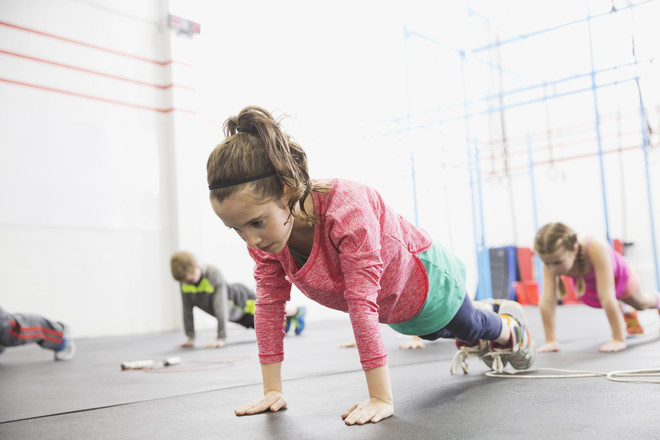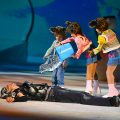Winter, peasant, triumphant... Oh, no, nothat. January, holidays, family leisure, active recreation. Where winter has finally arrived, mothers, fathers, and children are drawn to the skating rinks. Some even try to follow the example of Yana Rudkovskaya and Tatyana Navka - they put their little ones on the ice when they were barely 2-3 years old. But is it right? Will such zeal harm health? Is it possible to raise an athlete without harming health? We asked our expert about this. Pediatrician Nikolai Komov: Give children in the section is better not earlier than 6-7 years,if you, of course, care about his health, and not about the future career of a professional athlete. In the Olympic schools can take and earlier, but there everything is aimed only at the result. At 6-7 years old, choose a sport where flexibility develops, but there is still no burden on the skeleton. From 9 to 11 years can be given in team sports.
Give children in the section is better not earlier than 6-7 years,if you, of course, care about his health, and not about the future career of a professional athlete. In the Olympic schools can take and earlier, but there everything is aimed only at the result. At 6-7 years old, choose a sport where flexibility develops, but there is still no burden on the skeleton. From 9 to 11 years can be given in team sports. Photo: GettyImages
Photo: GettyImages
Which sport to choose?
From birth – swimming lessons with mother.From the age of 3 – children's fitness with mother. From the age of 5 – ballet, dancing. From the age of 6 – acrobatics, judo, wushu, sambo, figure skating, skiing. From the age of 7 – hockey, karate, hand-to-hand combat, freestyle wrestling, tennis, table tennis, swimming, gymnastics for girls. From the age of 8 – equestrian sports, karate, aikido, judo, cheerleading, modern dance, oriental dance, fencing, golf, gymnastics for boys. From the age of 9 – football, yoga, taekwondo, handball. From the age of 10 – triathlon, basketball, volleyball, snowboarding. From the age of 12 – boxing, kickboxing, mountaineering, rowing, powerlifting. Photo: Getty Images
Photo: Getty Images
How often should I practice?
 There is nothing more useful than general physical preparation. Two lessons per week is of little use if the rest of the time the child is sitting at the computer. Ideally, 3-4 hours a day, he must actively move. So, in 6-7 years, children need to walk 20-30 thousand steps daily, older children - already 40 thousand. But in our time, when everyone drives cars and sits at computers, it is difficult to provide a child with such a regime. Therefore, more and more children are obese - due to improper diet and hypodynamia.
There is nothing more useful than general physical preparation. Two lessons per week is of little use if the rest of the time the child is sitting at the computer. Ideally, 3-4 hours a day, he must actively move. So, in 6-7 years, children need to walk 20-30 thousand steps daily, older children - already 40 thousand. But in our time, when everyone drives cars and sits at computers, it is difficult to provide a child with such a regime. Therefore, more and more children are obese - due to improper diet and hypodynamia.
Does your health allow it?
 The main load in sports falls oncardiovascular system, and it should be in order. Therefore, first of all we make an electrocardiogram. If the doctor finds any changes according to the results of the examination, the child will be sent to the ultrasound of the heart. The main concern of doctors is how the heart will respond to increased stress. The results of an electrocardiogram and general examination of a pediatrician are usually enough. By the way, the certificate from the doctor now requires all qualified sections. If the pediatrician finds deviations, for example, deformities of the feet, which already causes complaints, he sends the child to the orthopedist. But in this case, the child is unlikely to be allowed to exercise, only physiotherapy. There are parents who come for help, keep silent about the past illnesses of the child. In order not to provoke an exacerbation, be honest with the doctors. There are diseases (atopic dermatitis, bronchial asthma), in which you can exercise, but in remission. If the child is on maintenance therapy, sections can not be spoken.
The main load in sports falls oncardiovascular system, and it should be in order. Therefore, first of all we make an electrocardiogram. If the doctor finds any changes according to the results of the examination, the child will be sent to the ultrasound of the heart. The main concern of doctors is how the heart will respond to increased stress. The results of an electrocardiogram and general examination of a pediatrician are usually enough. By the way, the certificate from the doctor now requires all qualified sections. If the pediatrician finds deviations, for example, deformities of the feet, which already causes complaints, he sends the child to the orthopedist. But in this case, the child is unlikely to be allowed to exercise, only physiotherapy. There are parents who come for help, keep silent about the past illnesses of the child. In order not to provoke an exacerbation, be honest with the doctors. There are diseases (atopic dermatitis, bronchial asthma), in which you can exercise, but in remission. If the child is on maintenance therapy, sections can not be spoken. Photo: Getty Images
Photo: Getty Images
If the child is tired
 Talk to your coach, assess the load – histask. Yes, during adaptation the child will sleep more, he will have an increased appetite. However, the loads in the sections are calculated in accordance with age. There are preparatory, middle, senior groups, so as not to overload the child - after all, this is harmful for his athletic success. And, of course, the child should enjoy sports. When choosing a section, first of all, take into account his wishes. Be prepared that he will change more than one sport before deciding on a choice.
Talk to your coach, assess the load – histask. Yes, during adaptation the child will sleep more, he will have an increased appetite. However, the loads in the sections are calculated in accordance with age. There are preparatory, middle, senior groups, so as not to overload the child - after all, this is harmful for his athletic success. And, of course, the child should enjoy sports. When choosing a section, first of all, take into account his wishes. Be prepared that he will change more than one sport before deciding on a choice.









